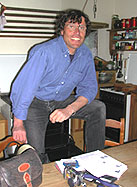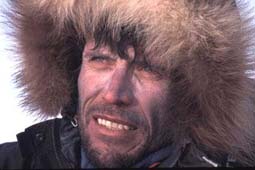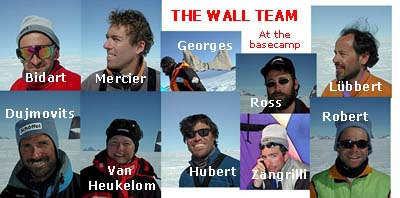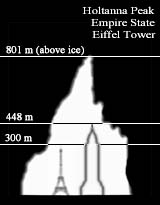|







|


|






|
For
the first time, antarctica.org
has passed the threshold of a million hits
in a month with 1.064.550
pageviews
during December
and 1.012.388 during January / thanks
to all our visitors
Look
at the fifty nice pictures in
the "Gallery"
See
also the Follow up of the other Antarctic Expeditions
DISPATCHE
13 : February 8th - 24th
 Saturday,
24 February : Alain Hubert is back home. Saturday,
24 February : Alain Hubert is back home.
 It
was snowday when Alain Hubert came back home. It
was snowday when Alain Hubert came back home.
He has to
wait several days to see back the ... green color.
The
time to develop the pictures, we will keep you inform in about one week
and we will present you a picture gallery and the latest news of the
expedition.
 Thursday,
8 February : "In a year, almost to the day, the departure of
the Great Arctic Crossing", explains Alain. Thursday,
8 February : "In a year, almost to the day, the departure of
the Great Arctic Crossing", explains Alain.
Once
arrived at Neumayer, Hubert sent us a brief word. A kind of initial
assessment of the expedition, and at the same time a leap into the future…
"We got to Neumayer OK. 60 hours in a tent waiting for the bad
weather to pass… We had the return of the fine weather just in
time for our arrival on the ice shelf: icebergs, penguins and so on…
So nice… It was also the first time that we saw the sun set for
a few hours. The colours are different, and it is all very beautiful.
The weather was overcast again the next day and it was in a total whiteout
that we crossed the last great area of crevasses that was between Neumayer
and us.
Apart from that, the crossing of the ice shelf was without any crevasses.
The welcome that the Germans afforded us was truly exceptional. We arrived
at the time of the "Taking Over" evening: a party to celebrate
moving from one team to another, an incredible buffet, well watered
until the early hours of the morning. 
We set up our tent at the end of a line of containers that house the
teams of the summer season… Funny, it's a bit like a toy lorry
when compared with our big lorries at home. But it kept the tent in
place, luckily, because the storm has returned and the winds are expected
to exceed 140 kph tomorrow. We are at the junction of two perturbations.
They don't get to see much fine weather here.
In a word, we are taking advantage of it to discover the base and its
scientific and logistical installations. This ice station is currently
at a depth of 10 metres. Built in 1992, they hope to be able to keep
it for another 10 years by raising the entry towers every other year.
On the other hand, they have to raise the weather observatories, air
chemistry, antenna and wind turbine every year … It's a model of
technology.
As for the Polarstern, it is staying in the free water until the storm
blows over (editor's note: see map graphic opposite), it will be arriving
on Sunday and we shall be leaving immediately to get to Punta on the
22nd. We are actually invited and therefore the guests of the Germans
here, which is a great honour for us little Belgians.
So this is the end of my Antarctic tour for another year. By the seaside
and on the sea, but it is in the North of course that the next great
expedition will commence in almost exactly a year from now!
This The Wall expedition was more varied and difficult to conduct that
I would ever have imagined. Like even in an expedition that I had thought
would be easier, there are always many unforeseen events. The month
of December was more stressful in view of the very packed programme
because of the fact that a part of the team had to leave at the beginning
of January, whereas from the outset we were running late because of
the late arrival of the plane. Then there was this question of safety
raised by the mediocre quality of the rock of the assault on the North
Stoop. The time therefore was going to be very short for climbing and
reaching the summit on time for the departure of the others. So what
should we do as regards the pictures that had to be shot, etc. So many
questions to which we tried to find an answer, and through which I tried
to assume my responsibilities as leader by taking a number of decisions
on my own and by letting the group decide other orientations in order
to keep everybody happy in the respective tasks that they had to accomplish.
A challenge through which we didn't navigate too badly, I think.
 The
summit of Holtanna was the first to be reached. And, even though the
South Stoop is totally different in the type of ascent required, and
that as a result we were going to be unable to use the portaledge camp
and to climb as had been envisaged, we shared the work, preferring in
the end the pictures of the first part of the stoop, which was not easy
because of the rotation of the sun that that did not in any way correspond
with our global hours. But the flexibility of Daniel and Ralph was able
to chime with the patience of our photography and film crew. I would
like to take this opportunity of thanking them. The
summit of Holtanna was the first to be reached. And, even though the
South Stoop is totally different in the type of ascent required, and
that as a result we were going to be unable to use the portaledge camp
and to climb as had been envisaged, we shared the work, preferring in
the end the pictures of the first part of the stoop, which was not easy
because of the rotation of the sun that that did not in any way correspond
with our global hours. But the flexibility of Daniel and Ralph was able
to chime with the patience of our photography and film crew. I would
like to take this opportunity of thanking them.
The very day after New Year's Day, after having been able to contemplate
the unfathomable grandeur of this continent from the summit in fine
weather, we found ourselves orphaned from three members of the expedition
who had to embark upon the second part of this adventure. The Educational
Project started much later than envisaged and found itself to be out
of kilter with the school timetable. Alain was going to have his work
cut out and he applied himself with great assiduity, sacrificing almost
every excursion from the base camp. We hope that we have been able to
shed new light on this continent for the children and for everybody
that has been following us. Katelijne, for her part, was devoted to
trying to transmit information to HQ about this gang of savages that
we are a little, no matter what one says, editing the pictures, and
putting up with the occasional remark from the boss at the same time.
In a word, a difficult job carried out little by little as the days
went by.
Ronald in a sense never ceased to work on the weather stations with
an astonishing meticulousness, guaranteeing, we hope, the outcome that
will be reserved for this initial experiment.

The pebbles and the places for finding lichen (a part of the work for
NASA) were the prerogative of Ronald, indefatigable, despite the endless
comings and goings of the photographer in the quest for good light,
etc. He brought a certain dynamism to the expedition. With André
Georges, we discovered, at the beginning of January, the surrounding
mountains. A kind of pilgrimage, a hundred years behind like at the
time of the first ascents in Europe. A real moment of relaxation for
me. After which, we went out on the ice shelf, a few bore holes to be
dug, too short unfortunately, the end of the expedition was nigh, logistical
problems that obliged some of our group to get to Blue One earlier…
Time passes too quickly at moments like this, but the imprimatur of
this continent will forever leave its mark in our heads, it was, we
believe, a unique experience. So now we are separated, some waiting
to leave for Cape Town from Blue One, while René and I are about
to embark on this extraordinary Polarstern, ready for a new adventure.
A huge thank you to all of you who have helped us to bring this adventure
to its successful conclusion and to share it with the greatest possible
number of people".
Alain Hubert
|
Last
minute (Wednesday, 07 February): Alain Hubert and René Robert
arrived without hitch at the German station, Neumayer, on 06 February,
where the hospitality was truly remarkable; they are embarking
on the Polarstern on Sunday. They should be arriving at Zaventem
on the 24th.
|

|




